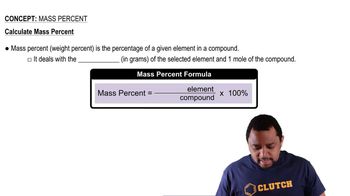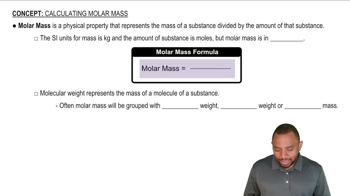Calculate the number of moles of solute present in each of the following aqueous solutions: (b) 86.4 g of 0.180 m KCl,
Calculate the number of moles of solute present in each of the following solutions: (b) 50.0 mg of an aqueous solution that is 1.50 m NaCl, (c) 75.0 g of an aqueous solution that is 1.50% sucrose (C12H22O11) by mass.
 Verified step by step guidance
Verified step by step guidanceKey Concepts
Molarity

Mass Percent Concentration

Moles and Molar Mass

Calculate the number of moles of solute present in each of the following aqueous solutions: (c) 124.0 g of a solution that is 6.45% glucose (C6H12O6) by mass.
Calculate the number of moles of solute present in each of the following solutions: (a) 255 mL of 1.50 M HNO3(aq),
Describe how you would prepare each of the following aqueous solutions, starting with solid KBr: (b) 125 g of 0.180 m KBr,
Describe how you would prepare each of the following aqueous solutions, starting with solid KBr: (c) 1.85 L of a solution that is 12.0% KBr by mass (the density of the solution is 1.10 g/mL)
Describe how you would prepare each of the following aqueous solutions, starting with solid KBr: (d) a 0.150 M solution of KBr that contains just enough KBr to precipitate 16.0 g of AgBr from a solution containing 0.480 mol of AgNO3.
